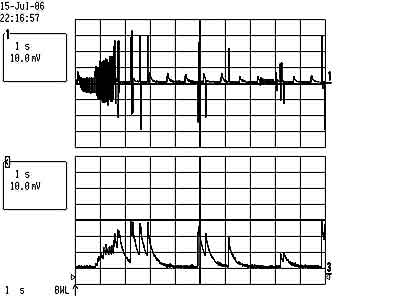

A growing collection of notes, focusing on diode mode stability measurements.
Return to home page
1) Summary
2) Capturing mode hops
5) Results for the Rohm RLD65PZB5 80mW/658nm laser diode
6) Results for the Mitsubishi ML120G21 80mW/658nm laser diode
7) Results for the "long open can" Mitsubushi ML101U29 150mW/660nm diode
8) Results for the Sony SLD1239JL-54 100mW/658nm laser diode
9) Results for the Sony SLD1236VL 80mW/658nm laser diode
10) Results for the Mitsubishi ML101J27 130mW/660nm laser diode
11) Results for the Opnext HL6385DG 150mW/642nm laser diode
12) Results for the Sharp GH04P21A2GE/PHR-803T 100mW/406nm "blu-ray"laser diode
13) Results for the Mitsubishi ML101F27 150mW/660nm laser diode
14) Results for the Nichia NDB7412 1W/445nm laser diode
15) Results for the Mitsubishi ML520G71 300mW/638nm, HL6388MG 250mW 637nm Opnext laser diodes
16) Results for the Opnext HL63133DG/170mW/638nm laser diode
17) Results for the Osram PL450/PL450B 80/100mW/450nm laser diode
18) Results for the Opnext HL45023TG 80mW/445nm laser diode
19) Results for the Opnext HL63603TG 120mW/638nm laser diode
20) Results for the Mitsubishi ML520G54/110mW 638nm laser diode
21) Results for the Osram PL520 50mW/520nm laser diode
22) Results for the Mitsubishi LPC-836 300mW/655nm laser diode
23) Results for the Sharp GH0631IA5GM 150mW/638nm laser diode
24) Results for the Sharp GH0631IA2GC 185mW/638nm laser diode
25) Results for the Sharp GH04580A2G 85mW/450nm laser diode
26) Results for the Osram PLT5 450B 100mW/450nm laser diode
27) Results for the Ushio HL63643DG 210mW/639nm laser diode
Local links:
Home-build instrumentation:
Off-site links:
So far, for SLM operation the best price-performance ratio for red diodes in ECDL mode are the HL63603TG and ML520G54. Among the most powerful is the HL63133DG, which is also the most expensive. However now in 2022 there appeared the HL63643DG that could even be better and is also inexpensive. Pretty good free-running SLM diodes are also HL6385DG and ML101J27 . It seems that the red diodes from Hitachi/Opnext/Oclaro/Ushio typically have better single mode behavior than others; that is, they tend to have at least some zones of reasonably clean SLM operation, in contrast to many laser diode brands.
On the other hand, green, blue and violet diodes generally run strongly longitudinal multimode when freely running and so are generally almost unsuitable for holography, however some of them can run reasonably well in ECDL mode. ECDL mode operation is described in more detail here and here.
Don't be fooled by statements in data sheets of "single mode" operation: What is meant is "single transversal mode" (= round dot) operation. Transverse multimode diodes such as ML520G71 , HL6388MG, NDB7412, and also high power transverse single mode like LPC-836, are totally unsuitable for single longitudinal mode (=single frequency) operation, which is needed for holography. If a diode runs multiple transverse modes to begin with, there is little chance to have it running in single longitudinal mode operation (though with lots of effort some marginal SLM operation at low powers is sometimes possible, eg. for NDB7412).
Sometimes data sheets mention even "single longitudinal mode" operation. I never have seen such a thing to be generically true for common consumer-type diodes. At most one can hope that SLM operation occurs in certain small sub-regions in the current-temperature landscape, as explained above. Actually I had investigated with a manufacturer in the past (I believe it was Opnext), and they confirmed that they rather had meant "single transversal mode".
Caveat1: Our results apply for test setups. To what extent a given diode works well for holography in practice, is a different issue. Stability is easily hampered by the smallest back reflections, esp. from a spatial filter, or can be modified even by just changing the collimation (due to the variable, minor backcoupling from the lens). Then there are aspects like: is a diode considered stable enough if it stays in a given single longitudinal mode for xxx seconds only? To what extent are weak side modes tolerable, which may reduce contrast or introduce banding? Etc.
Caveat2: The table below shows the behavior of few samples, typically 1-2 samples per type. There can be large variations within the same type, and one may be lucky or unlucky with a given sample. In addition, nothing guarantees that a diode doesn't change to the worse over time due to aging. Only individual tests and concurrent monitoring can tell!
Caveat3: Temperature indications in the plots below are only for orientation - to see whether a diode may in principle by useful or not. As warned above, there are large variations between samples, and on top of that, the relation between the actual temperature of the diode junction and what is measured by a thermistor embedded in the diode mount is highly uncontrollable - it strongly depends on details of the thermal contact of the diode. Moreover ordinary thermistors are accurate only to 1-2 degrees C anyway, so one shouldn't give too much weight to absolute temperatures in the first place.
Here is a summary of my measurements, modulo these caveats:
| Diode | Wavelength | P(multimode) | P(single mode) | P(ECDL) | Remarks | Summary |
|---|---|---|---|---|---|---|
| RLD65PZB5 | 658nm | 100mW @ 170mA | 30-40mW @ 80mA | bad | prob needs recheck | not very interesting |
| ML120G21 | 658nm | 80mW @ 140mA | 30mW @ 80mA | ? | weak extra modes at higher power | reasonable |
| ML101U29 | 660nm | 250mW @ 300mA | -- | >100mW @ 220mA | windowless | ECDL only |
| SLD1239JL-54 | 658nm | 120mW @ 170mA | 20-30mW @ 70mA | bad | windowless | not interesting |
| SLD1236VL | 658nm | 100mW @150mA | 20 mW @ 60mA | ? | not interesting | |
| ML101J27 | 660nm | 130mW @200mA | 40-90mW varies strongl | >100mW @ 160-200mA | >80mW SM at narrow spots | good overall value |
| GH04P21A2GE | 406nm | 100mW @110mA | -- | 15mW@50mA | very bad free running | ECDL only |
| HL6385DG | 642nm | 140mW@290mA | >75mW@175mA@ 15C | >100mW@230mA | excellend for ECDL | very good |
| ML101F27 | 660nm | 150mW@225mA | -- | bad | not interesting | |
| NDB7412 | 445nm | 1W @ 1A | 64mW@233mA@14.9C | 80-200mW, very unstable | not TEM00 | bad beam quality, unstable |
| 638nm 637nm | 300mW 250mW |
-- | bad | not TEM00 | bad beam quality, useless | |
| HL63133DG | 638nm | 170mW | approx 50mW | >100mW | moderately ok if free running |
ECDL best diode |
| PL450,PL450B | 450nm | 80-100mW | ---- | 40mW@110mA | very bad free running,3.8mm | ECDL only |
| HL4503TG | 445nm | 80mW | TBA | |||
| HL63603TG | 638nm | 120mW | <10mW | 70mW@125mA | mediocre free running,3.8mm | ECDL excellent |
| ML520G54 | 638nm | 110mW | <10mW | 60mW | mediocre free running,3.8mm | ECDL excellent |
| PL520 | 520nm | 50mW | --- | 40mW@150mA | very bad free running | ECDL good |
| LPC-836 | 655nm | 300mW | -- | --- | windowless | useless |
| GH0631IA5GM | 638nm | 150mW | <40mW | TBA | 3.8mm | narrow zone |
| GH0631IA2GC | 638nm | 185mW | <40mW | TBA | narrow zone | |
| GH04580A2G | 450nm | 85mW | <5mW | TBA | useless | |
| PLT5 450B | 450nm | 100mW | <5mW | TBA | useless | |
| HL63643DG | 639nm | 210mW | 40-120mW! | 120mW! | best price/perf. | excellent! |
2) Capturing Mode Hops via noise in laser output
One way to get a handle on laser diode stability and mode jumps is to look for noise in the light output; this has been described here, which I recommend for more background information. My hardware setup includes a large area photodiode behind an OD3 neutral density filter, which feeds a simple opamp acting as transimpedance amplifier, then an AC amplifier, and then a RMS detector based on the LTC1967. This is then optionally followed by a sample-and-hold circuit and a digital data acquisition unit (see below).
On a scope, the output then looks typically as follows:


Left pic: Current scanning. Upper trace shows raw input signal. Lower trace shows signal after DC rectifying and peak detector. Note the small periodic peaks in the input: they arise from the jumps in light intensity when the laser diode current is periodically stepped up by 1mA. These peaks do not make it through the signal conditioning circuit, though.
Right pic: Temperature scanning. Upper trace shows raw input signal. Middle trace shows signal after after RMS-to-DC converter LTC1967. Bottom trace shows signal after a sample-and-hold circuit which is necessary in order to capture the quickly varying signal with a low speed digital data acquisition system (see below); the periodic ramps are the integrated signal, and just before when it is reset (ie at the peaks of the ramps), the signal is read out to an ADC for digital processing. This integrated signal is a good measure for the noise and also captures brief signal bursts that would not be visible by the ADC because it is read out only once per second or even slower.
We observe that on the one hand (right) there can be sudden bursts of high intensity noise, indicating a transition through chaotic regimes, and on the other hand (left) there can be simple mode jumps where the output power suddenly jumps by a discrete amount but otherwise stays clean. My signal conditioning circuitry has been specifically designed to cope with this behavior. Further below I have correlated these measurements with spectrum analysis.
3) Longitudinal Mode Analysis via Optical Spectrum Analyzer
In fact, it turned out that just looking for noise in the light output is not sufficient to determine whether the laser diode is suitable for holography, at a given operating point. This is because noise typically just signals changes in the mode power spectrum, but even if the mode spectrum is stable and there is no noise, there can still be several modes present. On the other hand, if there is elevated noise, then the diode is unstable for sure.
The tool of choice for determining the mode spectrum of a laser diode is a grating based optical spectrum analyzer. Given the mode spacing of 100Ghz+ of a laser diode, it is better suited for displaying the spectrum than a scanning Fabry-Perot interferometer, because the latter has a usable free spectral range of typically just a few Ghz. In other words, the spectrum of a diode laser would "wrap around" many times, which would make it difficult to unambiguously identify the modes.
Click on the pic below for a brief movie that shows mode instabilities that occur when the laser diode current is increased by a few milliamperes.
This has been recorded off the scope screen, displaying the CCD output of my (mostly home-mode) optical spectrum analyzer.
Note that a single mode zone is crossed after a few seconds:
The resolution of the still picture is approx 0.12nm/div, and of the movie 0.3nm/div.
Moreover, I filtered the output of the spectrum analyzer circuit through a MAX9141 high speed comparator that triggers at an adjustable level. In this way one obtains an "effective line width" which measures the total range spanned by all the longitudinal modes. After an RC filter this then gives a DC voltage which is proportional to the total number of longitudinal modes that are present. Here a pic of how the comparator (output shown on the lower trace) acts such as to provide a voltage that is proportional to line width (rather than output power):
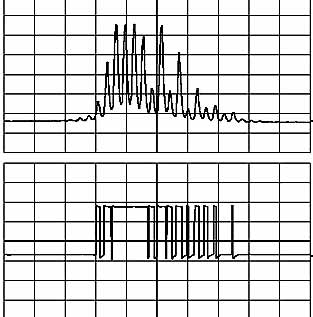
4) Digital Control (updated 2022)
My old equipment became obsolete after I redesigned and build from scratch my new digital laser diode driver system. One of its main purposes is to streamline and improve automated scans of linewidth and noise over diode current and temperature. It is described in detail here. Below is a movie that shows its operation:
This is connected to my CCD spectrum analyzer and a laptop. The traces on the scope are as follows:
The operation can be nicely seen in the movie: the cyan output line goes up in proportion to the line width and is lowest for single mode operation. This is what is color coded in the various scan pictures below.
The output is then streamed to a laptop running a LabVIEW interface. This picture shows the frontend for scanning over diode current and temperature:
After processing all data are written to a file from which the final plots are made (plots generated from the new equipment are shown from here).
5) Results for the Rohm RLD65PZB5 80mW/658nm Laser Diode (outdated)
Several thousands of those have been up on ebay "recently" for less than $10 each, so obviously they will be popular among laser hobbyists and deserve special attention from the holographer's viewpoint. They are rated at 80-100mW CW but pulse peak power is 240mW, so optically they should be able to do more than 100mW CW (perhaps with reduced lifetime).
Indeed so - I found for the first diode I tried that at 170mA and 15 degrees C, the output was already 108mW! This even with collimator optics, without them probably a few percent more. I didn't try to crank up the current more, though. The wavelength turned out to be at approx 654nm at 15C, which is not too bad either. The next two samples ran at approx 655nm (with similar output power) while others reported a wavelength of 661nm, so there seems to be some variance. At any rate, the wavelength shifts by approx 0.25nm per degree centigrade, and this needs to be taken into account.
The question is whether there are usable zones at reasonable power which are single-mode and stable, ie. mode-hop free. A systematic current/temperature "landscape" analysis of output noise was done, using the machinery described above, to see where stable and unstable zones of a given diode are.
Below on the left there is a landscape plot of the (effective) line width, which was obtained from the CCD spectrum analyzer via the digital machinery as explained above. It took almost a full day to complete... blue signals single mode, and we see that it does not occur much beyond 90-100mA. This corresponds in the best case to slightly more than 50mW, but typically the Rohm diode can do approx 30mW in single mode. At higher powers the diode runs strongly in multimode.
On the right there is, for comparison, a noise plot obtained in the same run. The gray regions indicate weaker and the black regions stronger noise (on a logarithmic scale -- the light gray regions correspond to a few mV of noise and the black regions to several hundreds mV). While there are obvious correlations between these plots, we see that low noise is not sufficient to guarantee a clean mode spectrum; as already noted, noise signals changes in the mode spectrum but does not really tell much about the mode structure as long it remains stable. From this it is evident that the noise scans are not too useful for determining a laser diode's suitability for holography!
Things should look different for each diode, and even for the same diode when removing and re-mounting it (because what counts is not the heatsink temperature, but the actual diode die temperature, which depends on the precise heat transfer characteristics between diode case and heat sink. Also adjusting the collimator lens can have an effect, as I found out). Note also that noise occurs where chaotic mode competition occurs; simple mode jumps can and will occur in any place when the temperature is changed, and preventing them over an extended period of time, requires to hold the temperature constant to a fraction of a degree.
Below there is a representative summary of an extensive analysis, where I have superimposed the line width and noise scans and plotted the actual spectrum at a number of selected points (click for a larger 2MB .pdf copy):
The little boxes display on the upper trace the spectrum at ca 0.12nm (85Ghz) per div, and the noise output on the lower trace.
The following observations can be made:
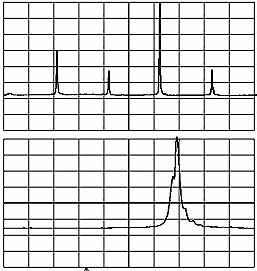
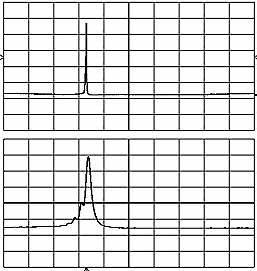
(upper part ca 200Mhz/div, lower part zoom with approx 20Mhz/div).
Thus, not surprisingly, the rule seems to be that whenever there is the slightest noise in the laser power, there is multimode behavior to some degree.
On the other hand, absence of noise does not guarantee the spectrum to be single mode; it just tells that it is stable.
6) Results for the Mitsubishi ML120G21 80mW/658nm laser diode
I obtained with no problem 82mW at 140mA at around 14 degrees C, even after collimator. I ran similar measurements as above, with the following summarizing results for linewidth (colored) and noise (superimposed grey/black) as function of temperature and laser current:
What is interesting is a relatively stable zone with small linewidth at low temperature and high currents; the power there is close to 80mW and thus is considerably higher than for the Rohm diode. Concretely I have re-checked the region near 13.5 degrees and 130mA with the scanning interferometer and the result is as follows:
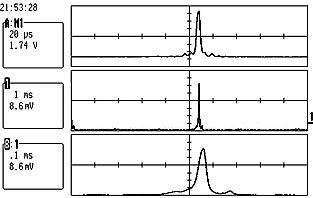
Upper trace: signal from CCD spectrum
analyzer, scale is approx 0.12nm/div
= 85Ghz/div
Middle trace: signal from scanning
Fabry-Perot interferometer, scale is approx
1/100 of the above, say 0.001nm/div = 300Mhz/div.
Bottom trace: ten-fold zoom of middle trace, which is approx 30Mhz/Div. Line width is thus at most 10Mhz, which means a coherence length of at least 30m.
This zone is not strictly single mode, as we do seem to see a few extra modes, but they are very weak so that they probably wouldn't harm a lot. This operating point at close to 80mW definitely deserves a test shot of a real hologram!
Thorlabs sells it as single mode diode, and as we see that its spectral data are definitely better than the other DVD diodes I tested; there are indeed large stable single mode zones but this does not exclude multi-mode zones to exist in-between.
7) Results for the "long die open can" Mitsubishi ML101U29 150mW/660nm diode
This kind of diodes, for which the die is in the open, can achieve very high power, in excess of 250mW CW. See eg. here for some information. I obtained a few of such diodes, and first confirmed these measurements: at 16C the laser threshold was at about 72mA, at 200mA the output was approx 100mW, and rising to 225mW at 380mA. This was using a simple Aixiz uncoated plastic collimator, with their coated glass collimator the power is approx 5% higher.
I don't really know the make of these diodes, but they should at least be similar to the long open can Mitsubishi ML101U29, which ``officially'' boasts 150mW CW output power; people report to have achieved more than twice as much, but that's a gamble and most likely dramatically reduces the lifetime of the diode.
At any rate, as for the mode spectrum I didn't expect any surprises, and in fact there weren't any. In short, these diodes are totally unsuitable for holography, as their spectrum is just terrible. Here is a linewidth scan over current and temperature:
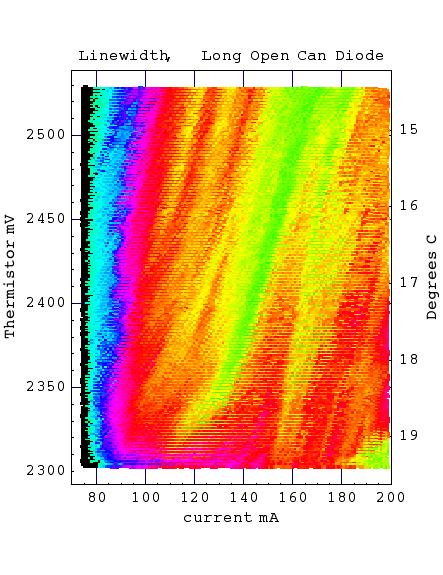
There is almost nowhere a single mode zone, not even at low currents. Below some representative shots, made via a LabVIEW interface to my CCD spectrum analyzer:
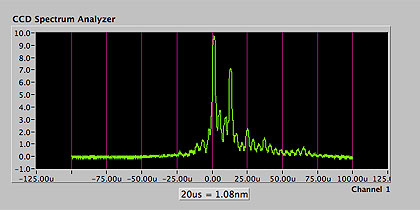 (I=180mA,T=16C)
(I=180mA,T=16C)
 (I=250mA,T=16C)
(I=250mA,T=16C)
(the labeling is not correct, it is rather 0.12nm per 20uS).
On the other hand, I found in an ECDL setup this diode is well capable of obtaining 100mW single mode - see here for details.
8) Results for the Sony SLD1239JL-54 100mW/658nm laser diode
This is a diode currently easily available on ebay. It is also of open can type, ie, there is no window and the bare die is exposed - this needs a very careful treatment. In multimode it can run to quite high powers, in excess of 200mW; I obtained approx 120mW at 170mA. Let's see what the mode analysis tells:
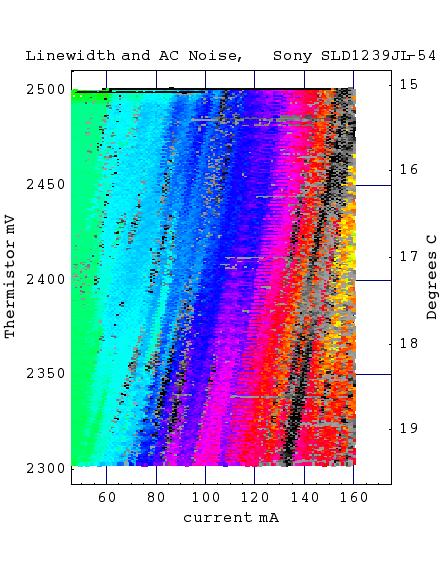
Colors indicate line width and the gray overlay AC noise in the laser output.
(Note that the colors should not be compared across different plots due different normalizations; for the two Sony diodes, green and cyan indicate single mode zones.)
So without any further discussion it is clear that the diode won't work well beyond approx 70mA, which yields approx 25-30mW. Even then there are mode hopping zones and one needs to carefully find a large enough stable zone.
I also checked an ECDL version and it didn't work well at all.
9) Results for the Sony SLD1236VL 80mW/658nm laser diode
This diode is similar to its more powerful sister above; in multimode I got 102mW out at 150mA after collimator. Here the result of spectrum analysis:
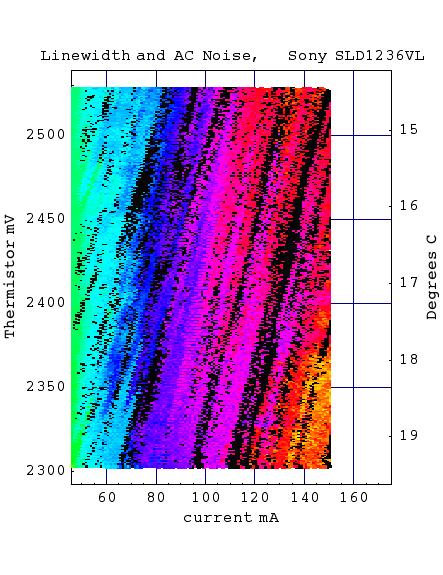
Like most DVD diodes I checked, it runs single mode only up to 60-70mA which yields 20-30mW. It seems more noisy with lots of mode jumps but that may also simply be an artifact due to a different noise voltage calibration, the pictures are not meant to be compared to each other.
10) Results for the Mitsubishi ML101J27 130mW/660nm laser diode
With the first diode, I achieved 38mW at 100mA, 81mW at 145mA, and 123mW at 190mA; with another I got 133mW at 190mA. Thorlabs lists this diode as single mode, though there is no mention of this in the data sheet. As for the landscape scan, I improved the signal processing circuits such as to directly count the number of modes and this (nearly) independent from the output power. Thus the plot looks slightly different to the ones before, but is more meaningful for cross-comparisons; cyan corresponds to single mode, defined by that there is no other mode present with more than 10% power; blue denotes two modes, and so on:
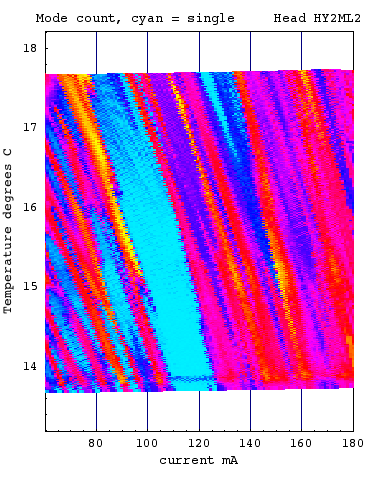
A sweet spot looks like this under the CCD spectrum analyzer (the following plots are for a different diode with slightly different pattern):
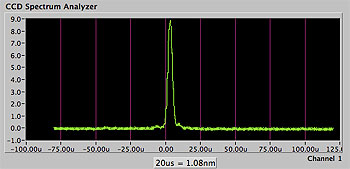 (I=110mA, P=48mW,T=16.6C)
(I=110mA, P=48mW,T=16.6C)
(the labeling is not correct, it is rather 0.12nm per 20uS).
A check with the scanning interferometer shows undeniable single mode with a line width of a few Mhz:

I noticed a large variation between different diodes, even out of the same batch; for three diodes I found single mode behavior at powers 50...65mW, one could do single mode only up to approx 40mW, and the last one was a surprise: approx 90mW at 140mA (however the single mode zone is quite narrow). Here the plots of the last two diodes I mentioned:

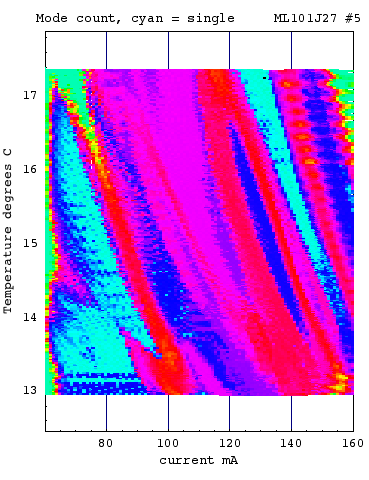
All-in-all, this diode has be best price/performance ratio of all I tested so far (unless one happens to get a bad exemplar such my #4). It performs also well in an ECDL configuration, but the problem of narrow zones is even more pronounced here.
11) Results for the Opnext/Hitachi HL6385DG 150mW/642nm laser diode
I bought a few of these due to a special offer from Photonic Products. As per data sheet, these diodes are classified "single longitudinal mode" and this, of course, strikes an holographer. Apart from the high power, also the wavelength is interesting, it is of a much warmer red than the usual 658nm diodes have, and this is of better use for color holography, the film sensitivity is higher, and also waveplates for 633nm HeNe are likely to work better as well. Here the landscape scan, where cyan corresponds to single mode, blue denotes two modes, etc:
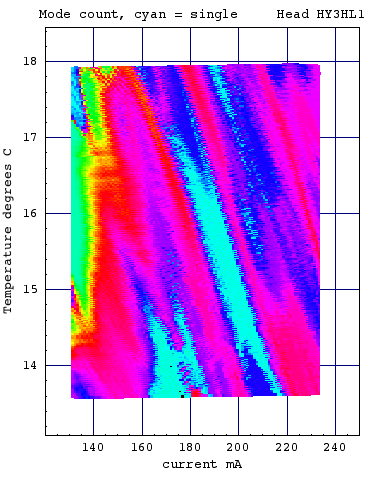
The good feature is the single mode zone at high power, up to more than 100mW, but it occurs at a in quite narrow band, and the challenge is to keep the diode running in such a band for long times without drifting out. Another challenge is to avoid moisture condensation at the required low temperatures. It may require sealing of the laser head.
For the second and third diodes I tested, the plot look quite different:
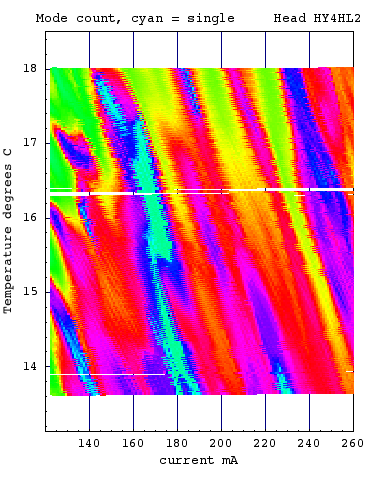
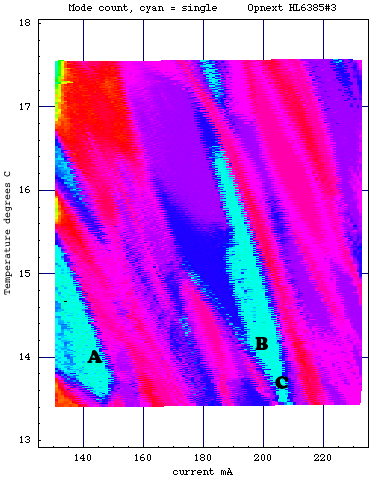
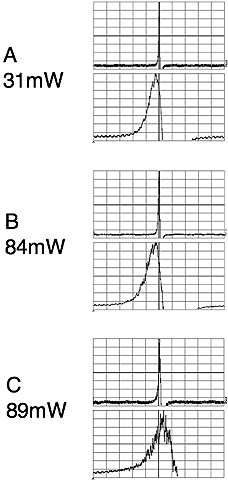
I also checked single mode zones in more detail with the scanning interferometer. Indeed there can be a fine structure that the CCD spectrometer cannot resolve. Above I indicated three locations and the corresponding SFPI spectra; in each display the upper trace shows an FSR of ca 2Ghz, and the lower trace, a tenfold zoom. That is, the scale on the lower trace is approx 20Mhz/Div. We see that at spot C the spectrum is noisy and this indicates an instability. Still the line width of ca 40Mhz should correspond to a coherence length of like 10m. I found that the spectrum is generically much noisier at high powers, and to what extent that matters in a hologram remains to be seen.
I now also tried that diode in an ECDL setup and the preliminary results are here.
12) Results for the Sharp GH04P21A2GE/PHR-803T 100mW/406nm "blu-ray" laser diode
This is an interesting little beastly close to the UV with a lot of power. My sample had threshold current at 35mA and achieved 93mW at 100mA and 20C, which is well consistent with these findings. Actually one should be able to tickle more power out but I didn't want to risk the diode before taking measurements. The power was measured behind a C330TM-A Geltech collimation lens which is AR coated from 400-600nm. With an Aixiz glass lens coated for red lasers the power was 70mW only, at 100mA (actually it is hard to measure power accurately with photodiode detectors at the edge of their calibration domain; I measured ten percent less power with my Newport 835/818-SL as compared to my Scientech and Laser Precision thermal power meters).
Unfortunately the spectrum turned out among the worst I ever have seen, it is strongly multimode almost everywhere in the current/temperature plane:
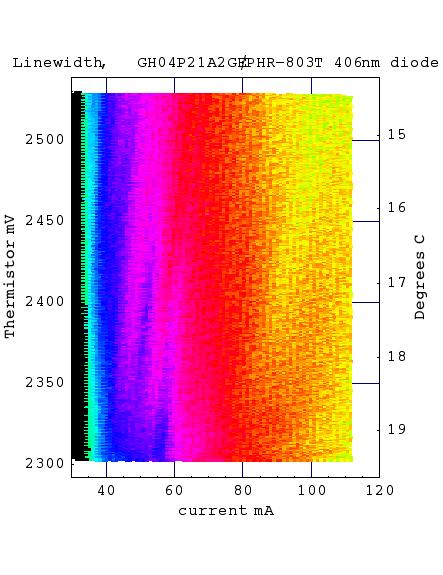
This is entirely consistent with the graph that is shown at the end of the data sheet. Here a few representative samples, all taken around 16C temperature (the horizontal axis was not properly scaled):
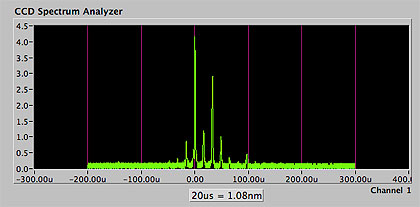 I=38mA ... multimode even just above threshold!
I=38mA ... multimode even just above threshold!
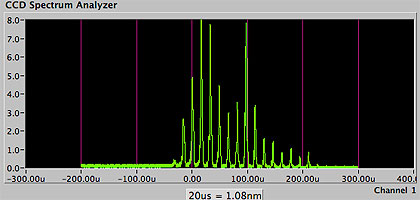 I=70mA
I=70mA
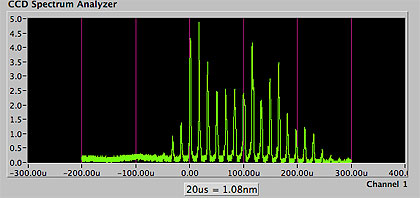 I=100mA
I=100mA
We see that with higher currents the higher total power comes from having more and more modes, and not from a single mode becoming all the time stronger. Let's crudely observe that each mode never gets beyond an order of 10mW. That seems to be the same order of magnitude that single mode ECDL lasers achieve; for my findings, see here.
13) Results for the "open can" Mitsubishi ML101F27 150mW/660nm diode
This diode is supposedly an upgraded version of the ML101J27, and I just got a couple of those. Indeed the power is higher, I got 150mW at 225mA with a Lens-27 with the first sample I tested. It is an open can diode like the ML101U29 and has similar specs. Indeed, my tests showed that it runs mostly multimode over the operating region:
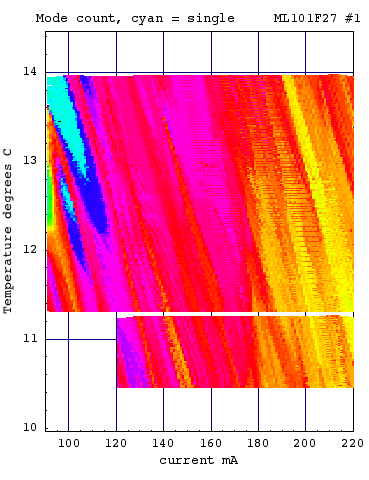
However, again similar to the ML101U29 it runs moderately moderately fine in an ECDL configuration.
14) Results for the Nichia NDB7412 1W/445nm laser diode
There has been incredible frenzy over the blue laser diodes that can be harvested for like $30-50 from a Casio A130/140 projector; see the turmoil at the various light show and balloon popper forums. There one can find further details about all sorts of things like beam profiles etc; in particular here. It seems that these diodes have the same data as the Nichia NDB7412 1W 445nm diode; despite of that the kind of these diodes is not yet entirely clear, I denote these diodes tentatively by NDB7412.
One drawback is the quite ugly transverse mode profile, and it will take quite some effort for beam shaping to eg., feed the light through a spatial filter efficiently. First beam cleaning tests were not promising; I intend to add a page on collimation, beam shaping and handling the transverse mode structure when I have gained more results and insights.
The holographer is of course mainly interested in the mode structure of these little beasties. Within the hour of receiving my first diode, I set it up and checked the mode structure with my home-built CCD spectrum analyzer (due to lack of a 1 Amp capable driver I had first to modify my SDL800 such as to allow it to run blue diodes with higher forward voltage). Et voila - without any systematic search, I immediately found that the diode runs single longitudinal mode at 55mW (with Lens-27 at 221mA and 15.4C) !
This was truly surprising, not the least because the diodes run transverse multimode. Some research of literature revealed that this mode structure typically arises for broad emitter diodes due to "filamentation" of the mode pattern, forming so-called extended "supermodes" which lase at the same frequency. These display a characteristic far-field pattern which arises from interference of coherent superposition. It seems that the situation we observed is exactly the same as the one discussed in this article on "Supermodes in Broad Ridge (Al,In)GaN Laser Diodes".
Here is a bunch characteristic samples we found:
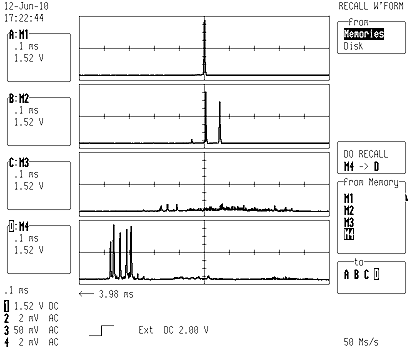
From top to bottom the current was 221mA, 225mA, 300mA, and 400mA at 16C. We see that at low powers, just one or a few supermodes are present, but at higher powers there is then chaotic competition of a broad multitude of supermodes. Note the beautiful single mode at 221mA!
Here is a little movie that shows the spectrum when the current is ramped from threshold to approx 260mA at 16C; note the beautiful single mode zone at 224mA:
Included is also sound that shows the noise in the light output. The popping sounds at the beginning indicate mode jumps. One can clearly hear how the single mode regions are correlated with low noise, which gives hope that a simple noise detector might be sufficient to determine the single mode regions.
Here the result of the first landscape scans, it was indeed a very pleasant surprise; as always, cyan denotes single mode behavior and we also have superimposed elevated noise in grayscale:
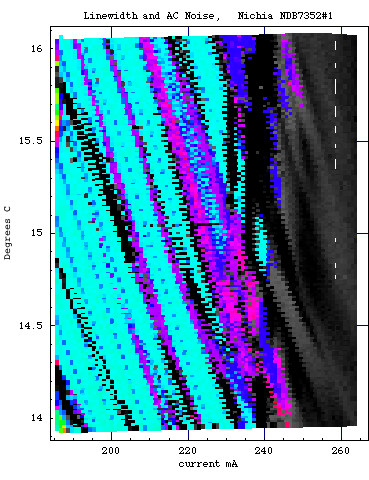
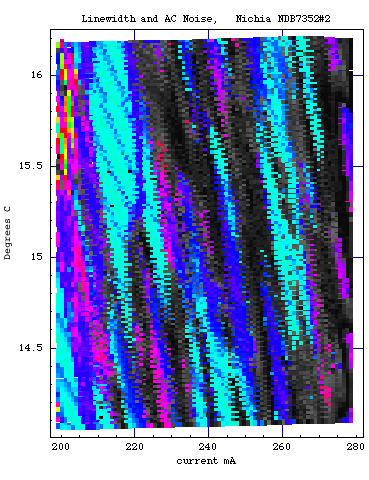
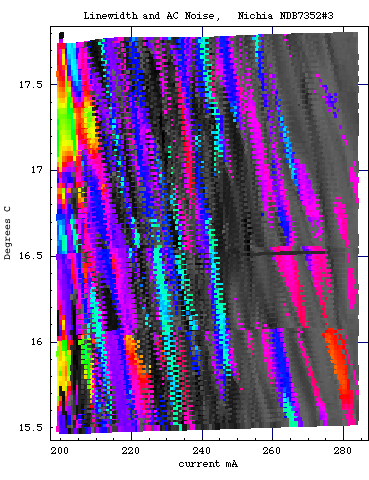
The first diode is somewhat better behaved than the second, and both are much better than the third. I checked a sweet spot of the first diode at 233mA and 14.9C to yield 64mW. This region is quite narrow, though, so it might be better to prefer a safer region. We see that the diodes differ quite strongly and I need to make more tests in order to see the typical behavior.
Here power plots of the diodes I tested so far; they can be pushed to beyond 1W but I didn't turn them higher because single mode cannot be expected at high powers anyway:
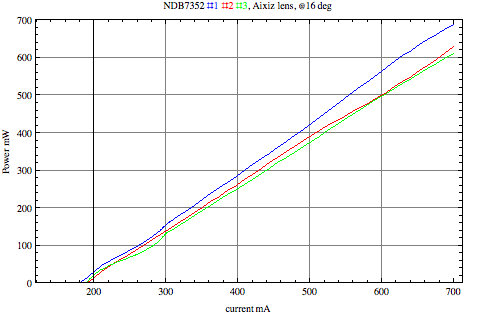
A first test in an ECDL configuration was disappointing but subsequent ones with a different grating were increasingly better, see here. It seems the over 200mW SLM is possible in an ECDL configuration, but only to approx 60-80mW is reasonably stable.
15) Results for the Mitsubishi ML520G71 300mW/638nm and HL6388MG 250mW 637nm Opnext laser diodes
These are high-power broad-stripe diodes which also run transverse multimode with a very bad beam profile. I couldn't find any longitudinal single mode spot, no matter what current or temperature were. One of the worst diodes for holography, and ECDL mode is not much better. Not worthwhile to present any further measurement data.

16) Results for the Opnext/Ushio HL63133DG 170mW/638nm laser diode
This is a narrow-stripe single transverse mode diode, which is similar to but better then the proven HL6385 (and definitely more expensive). It may be the best diode for holography operation, when disregarding the price. Here a plot of the free-running diode:

Blue zones depict single longitudinal mode operation (or close to it), and the power is a few tens of mW. Not bad!
Here a plot from a different sample, generated with newly improved equipment (2022):
 The spot at 23C and 175mA yields about 90mW at 635nm, so looks promising. On the other hand, closer inspection reveals that there are weak side modes present, which may degrade a hologram. These are borderline noticeable via the CCD spectrum analyzer,
The spot at 23C and 175mA yields about 90mW at 635nm, so looks promising. On the other hand, closer inspection reveals that there are weak side modes present, which may degrade a hologram. These are borderline noticeable via the CCD spectrum analyzer,
but are easy to see with the scanning interferometer.
However, in ECDL mode the diode totally rocks!
17) Results for the Osram PL450/PL450B 80mW/100mW/450nm laser diode (3.8mm case)
This diode was sold on ebay as the Opnext HL45023TG. It has quite similar data, so most wouldn't complain, but for purposes of single longitudinal mode operation there may be a major difference. At any rate, with respect to SLM it was among the worst ever seen, not the slightest chance of a SLM spot, quite similar to the 405nm blue ray diode. Here a characteristic plot of the spectrum at around 60mA:
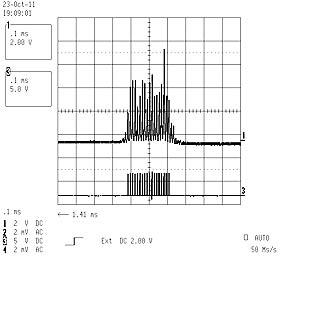
After tinkering, the diode performs fine in ECDL mode up to at like 40mW, for results see here.
18) Results for the Opnext/Ushio HL45023TG 80mW/445nm laser diode (3.8mm case)
Diode died, stay tuned.
19) Results for the Opnext/Ushio HL63603TG 120mW/638nm laser diode (3.8mm case)
This diode does not run too well when without feedback, no systematic tests done.
Performs excellently for ECDL; see here. Very good price performance ratio.
20) Results for the Mitsubishi ML520G54 110mW/638nm laser diode
This diode does not run too well when without feedback, no systematic tests done.
Performs excellently for ECDL; see here. Very good price performance ratio.
21) Results for the Osram PL520 50mW/520nm laser diode (3.8mm case)
Absolutely unsuitable when running free:

But it is pretty good in ECDL mode; see here.
22) Results for the Mitsubishi LPC-836 300mW/655nm laser diode
Totally unsuited for single longitudinal mode operation in either free-running or in ECDL setup. Not worthwhile to present any further measurement data.
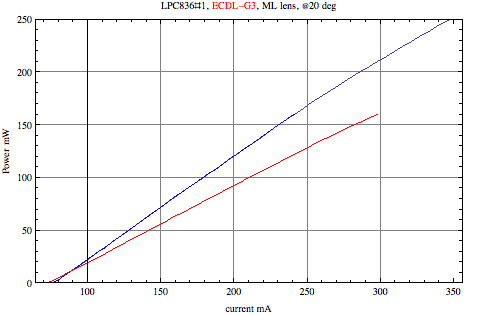
.....7 years break, now with new equipment
23) Results for the Sharp GH0G631IA5M 150mW/638nm laser diode (3.8mm case)
This is a nice little but powerful device, here are some plots:

We see a single mode zone at about 90mA/18.8C at about 40mW. Of course other samples may look very different, but at least this sample looks reasonable. Note also that absence of noise in the laser output does not signify single mode operation, see eg. the region at about 140mA and 18C. EDCL suitability to be seen.
24) Results for the Sharp GH0631IA2GC 185mW/638nm laser diode
This is similar to the previous one. I believe that it is the same chip except in a 5.6mm housing, as the differences between these diodes are not larger then the typical difference between samples of the same type:

Moderately stable singlemode operation appears to be limited to about 20mW for that sample.
25) Results for the Sharp GH04580A2G 85mW/450nm laser diode
This is like for more or less all blue laser diodes: when free running, almost unsuitable for holography in practice. ECDL performance remains to be seen. With some luck one may find a narrow single mode zone at a few mW, like the one below at about 35mA/23C with approx 10mW:

Thus the current must be tuned to within about 1mA to hit this zone.
Note that the noise is normalized such that the maximum is red. This does not mean that the noise is strong as compared to other diodes. In fact the noise for blue diodes is generally low.
26) Results for the Osram PL5 450B 100mW/450nm laser diode
Again, this is like for more or less all blue laser diodes: when free running, practically unsuitable for holography. Data sheet says "single mode" but transversal single mode is meant. ECDL performance remains to be seen.

Note that the noise is normalized such that the maximum is red. This does not mean that the noise is strong as compared to other diodes. In fact the noise for blue diodes is generally low.
27) Results for the Ushio HL63643DG 210mW/639nm laser diode
This is a brand new, inexpensive (~$25) diode and probably an improved version of the excellent narrow stripe diodes of Hitachi/Opnext/Oclaro/63643, such as the HL63133DG.
For now here the landscape scan results of the two six samples I got. The first one is good but not extraordinary: single mode operation near 85mA and 19C, which amounts to about 45mW:

The noise is cut off to the right as the amplifier went into saturation.
However the second sample was a real surprise: there is a (albeit very narrow) zone at about 148mA and 21C, which yields about 120mW!
Here a close-up of the spectrum at 148mA and 21C:
We see that the spectrum is not entirely clean, as there are weak side modes, but most likely they wouldn't be a problem for ordinary holography applications.Here plots of some more samples, to save space only the linewidth plots are shown:
Generally there is a large variation between samples of the same diode type, as far as the location of (approximate) single mode zones is concerned. However, interestingly, for the last four diodes which came from the same supplier, there is a universal SLM region with 60-75mW at about 110mA and 17-19C. Also, they were mounted and collimated in precisely same way. Minor variations in the heat transfer and/or in minimal backcoupling of the collimator can change the picture drastically.
This deserves to get a closer look, so here is a movie that verifies clean single mode operation of diode #6 with an SFPI:
As a caveat, here an example for the variablity for different mounting conditions. Minor back reflections from the collimator and/or other optics can change the resonance conditions and shift the landscape around. The diode HL63643DG #6 was put into a commercial laser module 56CRH/S2832 from Melles Griot, and indeed the scan for the very same diode looked quite different now:
More details about this laser diode module can be found here.
In ECDL configuration those samples that I checked turned out to work excellent. All-in-all the HL63643DG looks, so far, like the best diode, also in view of that it is not even very expensive!
More diode tests will follow over time.
Return to home page
Vers 4.3 6-2022